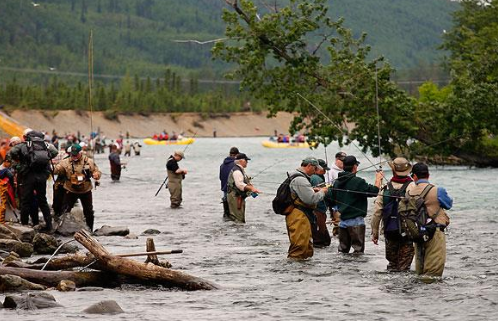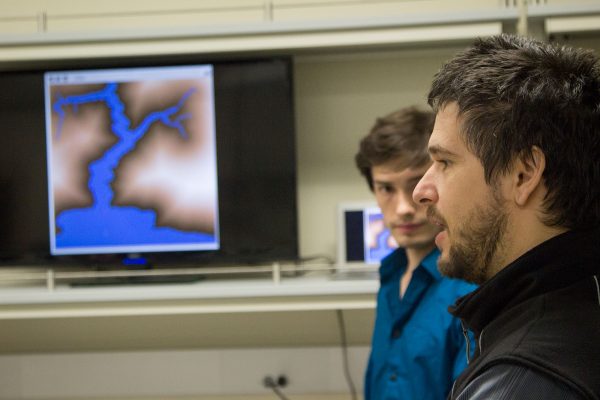Research: Using Kenai salmon runs to understand social-ecological change
by Kathleen McCoy |

Photo courtesy of Jenny Armstrong of University of Washington. From the EPSCoR Southcentral test case website.
How many times have you heard it this summer: "I love the weather we're having (long, warm and sunny days), but I'm worried about what it means (global warming)."
This unease comes from not knowing or understanding how this dose of the Bahamas is affecting the usually chill northern ecosystem. Maybe we're personally enjoying the back deck a whole lot more, but will our cold water-loving fish thrive? Will the plants and animals we're used to seeing sustain or disappear? Can we-cultural, commercial, sport and subsistence users-adapt to those changes?
Scientists from across the University of Alaska are working on exactly this problem. A five-year, $20 million grant for researching this overarching question is in its final of five years. Funding flowed through EPSCoR (Experimental Programs to Stimulate Competitive Research), with monies from the National Science Foundation and the state of Alaska. Four years of effort, including data, projects and teams, are catalogued on the Alaska EPSCor central portal, with separate sites for three focused efforts.
Asking the question
The umbrella project is called "Alaska Adapting to Changing Environments," or ACE. Three geographically distinct regions-the North (with UAF), Southeast (with UAS) and Southcentral (with UAA)-are sites for intensely collaborative investigations that include state and university scientists, policy makers and regulators, community partners and resource users. Each region is called a "test case." The goal of each case is to measure environmental change and also to explore the human capacity to adapt to that change.

From the EPSCoR Southcentral test case website.
The focus for the Southcentral test case is the Kenai River Watershed. Biologists, systems analysts and social scientists are collaborating to measure all kinds of environmental change there-from warming water temperatures to an increase in wildfire occurrence to recreational fishing pressure from Anchorage. A second goal is to share this information with community members and support their ability to adapt to these changes.
In a May 16, 2016 article in the Peninsula Clarion, UAA freshwater ecologist Dan Rinella described the Southcentral test case this way: "We're really trying to measure and make some predictions about how the physical landscape and climatic drivers are changing in the Kenai River Watershed, how these changes might affect salmon populations and how changes in salmon populations will work through the social and economic systems."
The same article offered insights on human adaptation to change, citing the work of Alan Boraas, a Kenai Peninsula College anthropology professor. Boraas explained that historically (1,000 C.E.), local residents had shifted from mid-summer sockeye runs to reliance on fall-run silver salmon. Boraas would like to know if climate change influenced that cultural shift.
"Adaptation is a two-edged sword," Boraas told the Peninsula Clarion. "If humans have values about the place they live, and in some cases love, and that place changes-do you do whatever you can to keep it from changing? Do you adapt to those changes even if those changes may result in a different environment than you wanted to live in? Or do you move?"
As you read all this talk of ecological change and adaptation, perhaps you're flashing on your own personal memories-some great Kenai Peninsula salmon fishing expeditions that you loved and dearly hope to repeat. You've struck the motherlode, the essence of the Southcentral investigation: What's happening to salmon on the Kenai? What changes can we anticipate? How will these changes affect our social, cultural and economic systems? How will we react?
Modeling fish migrations
This article introduces just one aspect of the Southcentral test case, the work of scientist Martin Cenek, a complex systems expert at UAA, with help from graduate student Max Franklin. Together they have created a computer model for showing salmon migration and end users, including drift gillnet, setnet and dipnetter fishers. Their model watershed is generic, but the program can be programmed to embrace specifics of any watershed, including the Kenai.

Martin Cenek, a complex systems expert, forefront, and graduate student Max Franklin, have developed a watershed model to study salmon migration with the goal of understanding how different resource management techniques may influence the goal of "maximum sustainable yield." They also hope to scale the modeling program for use in high school science classes. (Photo by Ted Kincaid/UAA)
Using 30 years of data, the team created a computer model for Kenai River Watershed salmon migration for the years 2002-2014. The model successfully mirrored dipnet dynamics with high fidelity, Cenek said. Set gillnet and drift gillnet dynamics fidelity was moderate, he said, and undergoing improvement. Now, they are interested in collaborating with resource managers. Ideally, they'd love fisheries managers with decades of experience to play with the model and test outcomes.
On a Tuesday afternoon in Cenek's windowless lab, Franklin loaded the program; together we watched a digital salmon run. "Every tick is about two minutes," Cenek explained as a river of red dots (salmon) flashed up the mouth. Other interim flashes of light represented drift boats, setnets and dipnetters, all at work at different or shared times, harvesting the resource. "Every time you see a black 'x,' a salmon was harvested," Cenek said.
All the fishers in the model run are scaled from actual data. So one dipnetter on the screen might represent 20 actual dipnetters from the data. One fish "agent" might be 60 salmon, wiggling up the creek.
It took Cenek and Franklin a year and a half to create this computer model from scratch. Testing its accuracy was the first order of business. Now that they have that, they are anxious to share it with their Southcentral collaborators.
One of the findings from the model is a demonstrated "flaring" in the harvest and end-user data over the last five years, a discrepancy between fish resource and consumer experience. Cenek referred to it as "instability" in the run. He explains:
"So for instance, a dipnetter might be seeing a normal run size, so they plan to put in a corresponding amount of effort to catch fish. Something like, if I put in eight hours, I would expect to catch eight fish. But if I suddenly get 15 fish, or I only get three fish, they can no longer count on the effort they put in to yield the expected fish." That's instability, and they see it arise only in the very recent past.
What does that tell us? "We don't quite now yet," Cenek said. "Will it keep going? We don't know yet." But with the model, they would hope to simulate many different scenarios to test different outcomes in the run.
Cenek explained that in Southeast Alaska, one salmon run that is normally nine weeks is now compressed to seven. "So it shrunk. It was normally a double hump kind of distribution. But the earlier hump is gone..."
Their new software model might allow the scientists and resource managers to test similar changes on the Kenai River Watershed. What if the Kenai run, normally from July through early August, shifted two weeks earlier, or two weeks later. They could run that scenario on their model and look for changing outcomes in the harvest and the end user experience.
Fish data vs. human data
Something Cenek commented on is that information on salmon and their runs is abundant; information on consumers is much more limited.
"We have very little on human behavior," he said. "So...how many people fished in 1983 at this location, and what type of gear did they use? We have no idea."
Yes, there is data on fishing licenses, but few specifics. They want to know much more about the stakeholders. "How long did they spend at a specific location?" suggested Franklin. "What is their favorite spot to fish at? What causes them to move to another spot?"
Other variations they can conceive of modeling: "To give you an idea of the various things we can alter and play with here-you can change the net depth of the stakeholders," Franklin said. "You can change the number of permits for commercial fleets, you can change the emergency order restrictions as well. There's a plethora of different variables that we can play with here."
The benefit of an accurate computer model is the ability to test different resource management strategies. Because the Kenai salmon runs are managed for "maximum sustainable yield," the goal is for all stakeholders to harvest as much as they can while the system is able to reproduce recurring high numbers of fish. Cenek believes that the many different ways this can be accomplished have yet to be tapped, and that their computer model can help.
"We have talked to a lot of managers, and they literally have 30 years of experience managing fisheries. And that counts for a lot. That being said, we humans, we are very pattern- and experience-oriented. So, if I would ask you to design a bicycle for me...."
"I would think of two wheels," I answered. Exactly.
"They say, 'We managed the fisheries last year this way, and it worked for us. It must be good. Without totally realizing what factors may have made it a success."
Ideally, Cenek and Franklin's salmon migration model might let fisheries managers play with more and different variables-Cenek calls them "joy sticks," to digitally test new strategies for successful and sustainable fish runs.
Cenek and Franklin have already delivered one paper and have two more in the works. They are just one small piece of this gigantic jigsaw investigation on the Kenai River Watershed. With expertise from all stakeholders, the goal for the Southcentral project is to more fully understand how the Kenai ecology has changed, how it has affected fish runs, and ways that humans, the end users and consumers, can best adapt to those changes.
Everyone is on board for the work, Cenek and Franklin said, readily sharing data and conferring on meaning.
"Basically, everybody here is trying to understand this, for the greater good of society and for the resource," Cenek said.
Written by Kathleen McCoy for the UAA Office of University Advancement.
 "Research: Using Kenai salmon runs to understand social-ecological change" is licensed under a Creative Commons Attribution-NonCommercial 4.0 International License.
"Research: Using Kenai salmon runs to understand social-ecological change" is licensed under a Creative Commons Attribution-NonCommercial 4.0 International License.









